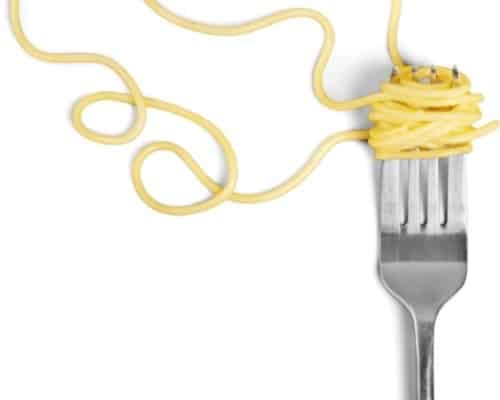Pasta is delicious and flavorful, making it a staple in various households and even in whole cuisines. It can be served with meats, sauces, veggies, and everything in between, making it a very versatile food.

But, as you may know, pasta is high in carbs, so it doesn’t make for a very nutritious food unless it’s served with some protein and healthy veggies.
Aside from that, there’s a lot more to pasta than meets the eye. So, let’s take a look at the pros and cons of pasta.
There are mixed reviews when it comes to pasta and its health benefits, but it all depends on the kind you buy. White pasta made with refined carbs isn’t very healthy and provides you with empty calories.
Whole-wheat pasta, on the other hand, is higher in nutrients and more filling. But there’s a lot more to the pros and cons of eating pasta.
Table of Contents
Pros of pasta
When adding pasta to your diet, it’s important to choose enriched or whole-wheat pasta types. These are healthier, higher in fiber, and richer in various nutrients that contribute to good health.
These types of pasta are also less fattening, which means that you can safely consume more without worrying about weight gain.
Whole-wheat pasta is also available in various forms, including spaghetti, ravioli, casarecce, fusillini, and many others.
Whole-wheat pasta is rich in manganese. A one-cup serving of this pasta type contains almost your whole daily recommended need for this mineral.
Manganese improves bone health, works as a powerful antioxidant, and even reduces inflammation. It also works in combination with other minerals and vitamins and helps regulate blood sugar levels, which is helpful for people struggling with diabetes.
Some studies found that consuming whole-grain or whole-wheat pasta helps lower appetite and increase fullness. This is beneficial for people trying to lose or maintain a healthy weight.
It may also help regulate blood sugar levels, which is important since spikes in blood sugar levels might lead to fatigue and even developing type 2 diabetes.
While studies are unsure how much whole-grain pasta can help you, it’s certainly a healthier option than refined pasta.
Pasta is also a wonderful source of selenium. It’s not only a healthy mineral but also a powerful antioxidant that helps flush free radicals out of your body.
Selenium also helps protect you against heart disease and even certain types of cancer. This mineral is often found in nuts and grains, so whole-wheat pasta is an excellent food to consume if you want to load up on this nutrient.

- Choice of whole wheat pasta
- Rich in manganese (bone health)
- Lowers appetite
- Rich in selenium (protection against heart disease)
Cons of pasta
The main downside to pasta is that it’s very high in carbohydrates and low in protein. Diets high in carbs have been linked to an increased risk of developing diabetes, metabolic syndrome, and even heart conditions.
Carbohydrates are also the leading cause of weight gain as they don’t make you feel full after eating, which means that you’re more likely to consume a lot more than a standard serving.
What’s more, foods high in carbs have a higher glycemic index, making it not only bad for your blood sugar levels but also for your energy levels.
Most pasta is high in gluten, which may cause problems for some people. This type of protein causes an immune response and damage to the small intestine cells in people with celiac disease.
Even if you don’t suffer from this condition, gluten is still harder to digest than other types of protein.
Because of that, it may cause stomach problems and digestive system inflammation. On the bright side, there are many gluten-free options on the market – some pricier – so you can still eat pasta even if you don’t tolerate gluten.
Another thing to consider, especially if you’re trying to lose weight, is that pasta is high in calories. Just one cup of cooked pasta contains 174 calories, which is a lot considering all the other ingredients you’ll add to make the finished meal.
Both whole-grain and refined types of pasta are rather high in calories. So it’s important to carefully control your portion sizes since it’s very easy to cook and consume too much pasta.
When adding additional ingredients to your pasta, it’s also important to add fresh, healthy foods. A lot of people eat pasta with sauces made with heavy cream, covered in cheese, and other fattening and unhealthy foods.
When that’s the case, calories add up, and you’re losing any potential health benefits that your meal had in the first place.

- High in carbohydrates
- Low in protein
- High in calories
- High in gluten
How can you make pasta healthier?
Even though pasta is high in carbs, it doesn’t mean that you have to remove it from your diet altogether.
To ensure that eating pasta won’t cause weight gain or other health problems, try choosing whole-grain or egg pasta options. These are higher in nutrients and don’t cause severe spikes in your blood sugar levels.
It’s also a good idea to pair your pasta with fresh ingredients, such as spinach, tomatoes, chicken, fish, shrimp, and many others. That way, you can create a well-rounded meal without sacrificing the foods you love.
It may also be a good idea to ditch store-bought sauces, such as spaghetti sauce, sweet & sour sauce, and other canned gravies.
These are usually loaded with sodium and other bad additives for your health and increase the risk of developing many health conditions.
This doesn’t mean that you can’t eat pasta with sauces, though – simply try to make healthier choices and make the sauce yourself. You’ll be surprised how easy it is, and you can also store it for later.
Depending on the way you prepare your pasta, it can be a great addition to a healthy, balanced diet. To get the most out of your pasta, choose whole-grain kinds and eat them with a side of fresh veggies and good protein sources, such as meat or beans.
That way, you can reap the benefits of eating pasta without worrying about the downsides. And, as always, make sure to consume everything in moderation.
Don't know what to drink? Check out these articles: 20 Most and Least Acidic Juices and 20+ Alcoholic Drinks Ranked by Acidity Level
